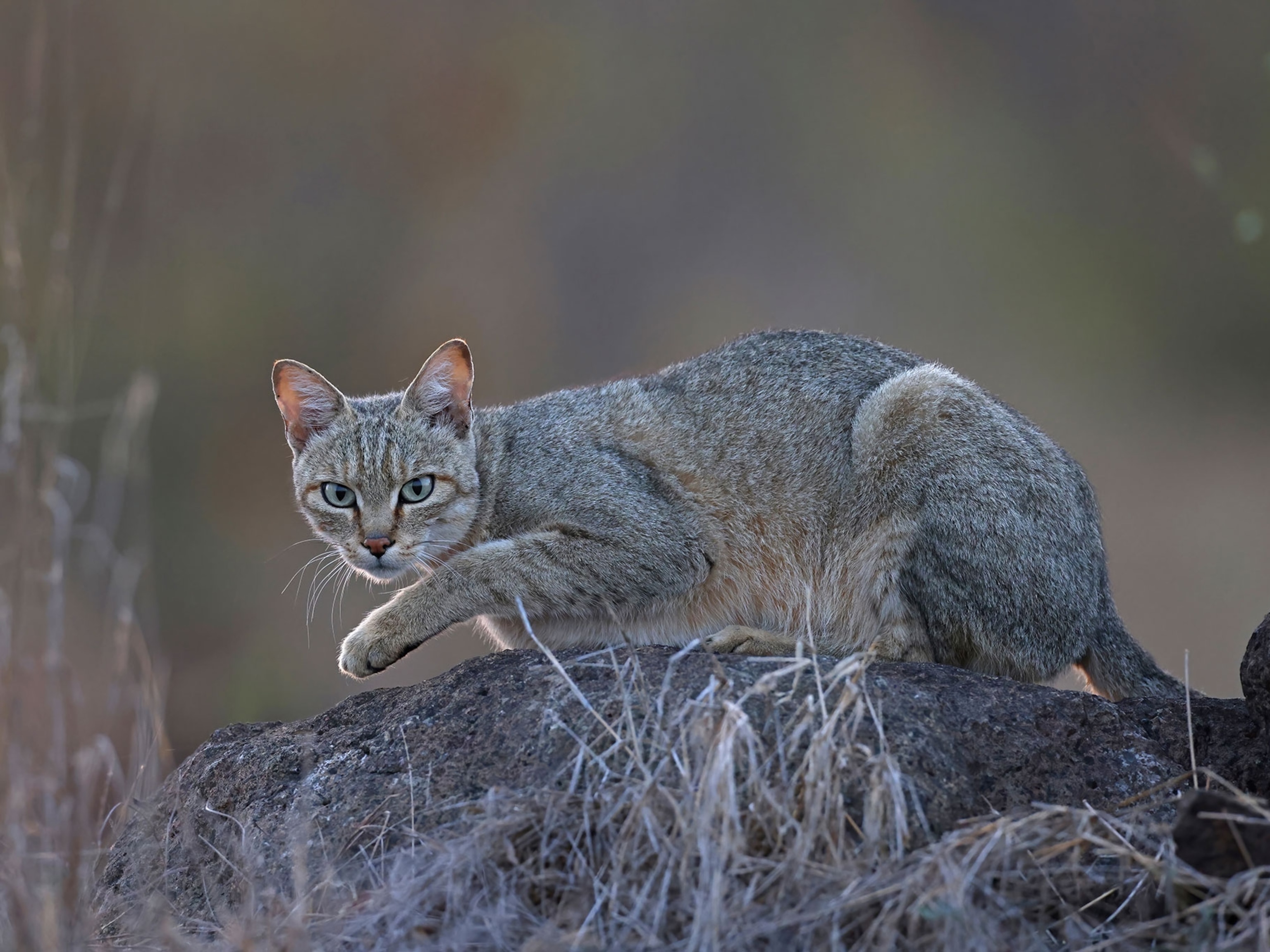
How to Resurrect Lost Species
Genetic experiments could bring back extinct animals.
Will we ever see a woolly mammoth again? What about the striped Tasmanian tiger, once-prolific passenger pigeon, or the imposing wild cattle called aurochs?
Our species has played a role in the extinction of these and many other species. But now some scientists are proposing a radical turn of the tables: Bringing lost species back from the dead.
Video: Recipe for Resurrection
Three main methods for "de-extinction" have been proposed. Cloning gets the most attention, thanks in part to the science fiction of Jurassic Park. We probably won't ever see a Tyrannosaurus—despite the discovery of degraded soft-tissue remnants in fossilized dinosaur bone, no one has ever found non-avian dinosaur DNA—but cloning is plausible for less ancient creatures whose genomes can be reconstructed.
And while mammoths tend to hog the spotlight when such proposals are discussed, researchers are also considering resurrecting other species that might not be as famous, but are equally charismatic. (See "Pictures: Extinct Species That Could Be Brought Back.")

The thylacine, also known as the Tasmanian tiger, is one such lost species. These striped carnivores appear superficially doglike but are actually marsupials that once roamed Australia, Tasmania, and New Guinea. A combination of causes—most prominently hunting and trapping by humans—totally wiped them out by 1936.
But as paleontologist Michael Archer has realized, the relatively recent extinction of thylacines means that museum specimens can still yield viable genetic material. When he was the director of the Australian Museum in the early 2000s, he and his colleagues extracted DNA samples from the teeth, skins, and dried tissues of thylacines in the museum's collection.
Obtaining those genetic sequences was just the first step, though. The DNA is in fragments, and the next major task will be assembling all those snippets into the whole genome of the thylacine.
Although Archer discontinued the project when he left the museum for a position at the University of New South Wales, he's optimistic that researchers can someday pick up where he and his team left off: "As technology improves, and sequencers get better and better, it would be a brave person to declare that the whole nuclear genome won't ever be able to be reconstituted."
If the thylacine genome is completed, the next hurdle would be using it to create a viable pup. Archer suggests two possible routes. One way would be to combine the nucleus of a lab-created thylacine cell with an egg of a Tasmanian devil, another carnivorous marsupial, that had its nucleus removed. The resulting embryo could be implanted into the uterus of a Tasmanian devil, potentially resulting in the birth of a thylacine.
Alternatively, Archer said, scientists could try a less direct approach. "A cell line of living Tasmanian devil cells could be used to progressively splice in thylacine sequences to replace the corresponding regions of the devil chromosomes." Repeated over and over again, such a method could eventually produce a thylacine. A 2008 study in which thylacine DNA was successfully spliced into a mouse hints that such a method might be successful.
"I wouldn't want to make light of the challenges involved in any of this," Archer said. Yet he believes such a project may become feasible in the future. "It can't be done now—but that was true 20 years ago for many things that can be done today." Indeed, he said the biggest hurdle for cloning "could be the widespread conviction that it's a waste of time to try." (Related: "Species Revival: Should We Bring Back Extinct Animals?")
Video: Should We Resurrect Extinct Species?
Return of the Passenger Pigeon
Cloning might not be the easiest, or best, route to de-extinction in some cases. If a close relative of a lost species is still alive, researchers can tinker with that genome to "reverse engineer" the extinct species. That's how some ornithologists and geneticists envision bringing back the passenger pigeon.
The passenger pigeon used to thrive in great numbers in North American forests, so abundantly that few people would have imagined the birds' extinction was possible. Their flocks were said to take days to pass by. Sport shooters could easily get scores of them in a single outing. Yet hunting and habitat loss took a severe toll, and the species' population had plummeted by the early 20th century. In 1914, the very last known passenger pigeon died in the Cincinnati Zoo.
Researchers now see an opportunity to resurrect the passenger pigeon from the inside out, using its closest living relative: the band-tailed pigeon.
At the "Bringing Back the Passenger Pigeon" meeting held at Harvard Medical School last year, geneticist George Church proposed sequencing the genomes of both the living and extinct birds and studying the differences. With that information, researchers could tweak the genome of the band-tailed pigeon to create a bird genetically and physically identical to the passenger pigeon.
Perhaps the biggest challenge, as Church noted, would be combining all the desired traits—including behavior—in one bird. Reviving the passenger pigeon, or any other extinct species, would require a comprehensive knowledge of how an organism's genome is translated into anatomy and behavior.
Breeding Cattle Backwards
There may be an even simpler way to revive some lost species, such as aurochs, the ancestors of domestic cows. Aurochs survived alongside their domesticated descendants until the early 17th century, when the species ultimately succumbed to disease, habitat loss, and human mismanagement.
Now, scientists including Henri Kerkdijk-Otten of the Megafauna Foundation hope to re-create the aurochs through a process called "breeding back." Starting with domestic cattle, the process uses strategic mating to incrementally restore the anatomy and the genome of an extinct animal.
The advantage of such an approach, Kerkdijk-Otten says, is that it would utilize cattle already adapted to the world's present ecology, rather than trying to re-create an animal from a different time and climate. "If we start with regional primitive cattle breeds with a lot of aurochs characteristics, we will ensure a cattle breed that is maximally adapted to local circumstances," he said.
A scientifically guided mating program could eventually combine aurochs-like traits from living cattle into one lineage. Some human assistance—such as artificial insemination and embryo transplantation—might be necessary along the way. The goal, Kerkdijk-Otten says, is to get "cattle herds that live wild and independently and consist of individuals with the highest amount of aurochs characteristics possible."
How would researchers know when they had actually recreated an aurochs? By combining information from cattle genetics, zooarchaeology, isotope studies of diet, and even prehistoric cave paintings and rock carvings to "devise a blueprint" of the critical characteristics that make an aurochs an aurochs, said Kerkdijk-Otten.
Ultimately, researchers could also compare the DNA of the new creatures with the original aurochs genome, which is currently being reconstructed.
The Dream of De-extinction
If de-extinction succeeds, a big question looms over any of the methods proposed: What will become of the animals created? Even if lost species can be brought back to life, it doesn't mean they can be successfully returned to the wild.
Kerkdijk-Otten is working with groups such as Rewilding Europe and the European Wildlife Organization to find a place for his project's wild cattle to roam. Likewise, Archer would like to see the thylacine returned to its former range. He views it as a kind of penance: "In the 1800s, we deliberately set out to slaughter as many thylacines as possible. Hence I would argue we have a moral imperative to try to undo colossal disasters of this kind for which we are responsible."
Restoring lost species is controversial, especially when there are so many endangered living species and imperiled ecosystems worthy of scientific attention. Yet there may be points where the two causes intersect. De-extinction techniques might also be used to clone rare species or to introduce genetic variability into species that are at risk of inbreeding because of small population sizes.
"The struggle to bring de-extinction into reality requires far more effort and resources than would be needed to conserve endangered living species," Archer said, "so why not focus on stopping species from going extinct in the first place?"
And in terms of tangible ecological benefits, Archer believes thylacines could kickstart interactions that would benefit other species. Tasmanian devils, the small and carnivorous marsupial cousins of thylacines, suffer from a devastating disease called devil facial tumor syndrome that is transmitted when they bite each other. Archer hopes that reintroduced thylacines would break up Tasmanian devil populations in a helpful way.
"If the thylacine could be put back, it would compete with the Tasmanian devil for food, as it once did," Archer said, therefore "keeping smaller devil populations under control and hence less capable of spreading [the facial tumor] disease across the whole of Tasmania."
For the moment, de-extinction remains a dream. But it's not an implausible one. By combining clues from the past with new techniques, researchers are exploring pathways to re-create species that we never thought we'd see again. The future might contain vestiges of the past.
Editor's note: National Geographic will host scientists and conservationists at the TEDxDeExtinction conference on March 15 at its Washington headquarters, spearheaded by Stewart Brand and Ryan Phelan of the group Revive and Restore. The event will be streamed live on NationalGeographic.com. National Geographic will be reporting on the conference and related debate in coming weeks, including in a cover story in our April issue.








